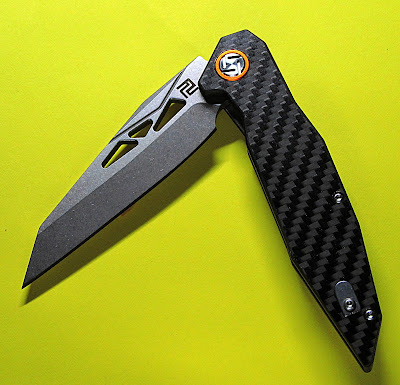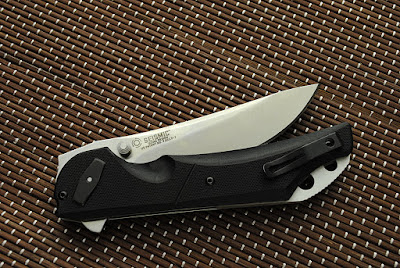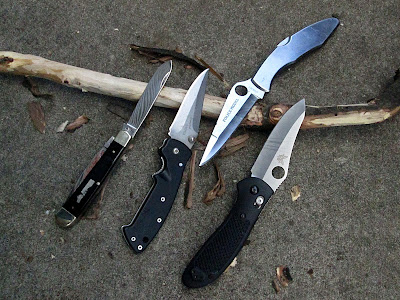The Cygnus from Artisan Cutlery
is amazing. The carbon fiber handle is
backed with a steel insert on each side for stability and to anchor the liner
lock. The blade is stone washed D2
steel and is fashioned as a reverse tanto saber grind. There is a tiny false edge to move the blade’s
center of gravity farther out from the pivot point. This is assisted by three triangular openings
in the top of the blade. There is mechanical advantage gained by having the
acting center of mass extended from the fulcrum or pivot point.
Enough of the physics, just know
that when propelled by the flipper the blade flies open on ceramic ball
bearings. When the knife is locked open
the flipper becomes part of the guard to keep your fingers off the sharpened
blade. I’m always appreciative of that!
Artisan Cutlery describes the
blade as a drop point, but in my experience, drop points are curved and
gradual. This area is a downward slash
and gives the blade its strikingly good looks.
The diamond cut outs add to its appearance. It looks as if the open knife is already in
motion even when it is standing still.
 |
| Back side closed |
D2 is an excellent choice for a
blade steel. Not quite stainless, it
requires a drop of oil now and again, but D2 tool steel is a versatile air-hardening
steel with good resistance to wear from sliding contact with other metals and
abrasive materials. With a HRc of 58-60 the blade will give you good edge
performance and can be sharpened with ordinary stones.
Here are a few more specifications
for you: The blade is 3.5 inches long,
0.15 inches thick and the open length of the knife is 8.5 inches. The clip is reversible for left and right
carry and a lanyard pocket is built into the spine. The total weight is 4.23 ounces. The Cygnus is worn tip up in your pocket, my
favorite carry position.
I’m impressed both by the ease of
opening as well as the stylish good looks.
You’ll get quite a few compliments with this knife. Rub your fingers over the surface, look and
touch for rough spots and mis-alignments.
I didn’t find any. Feel the lock
up and hear the snick when the blade closes.
The flipper is constructed to prevent the sharpened edge from dulling
against the closed back of the knife.
There is a lot to like about this knife.
After you buy one, spend a few
moments preparing for all the compliments you’re going to get. Tell ‘em they can get their own at:
Artisan Cygnus is $69.99, Don’t be left out.







